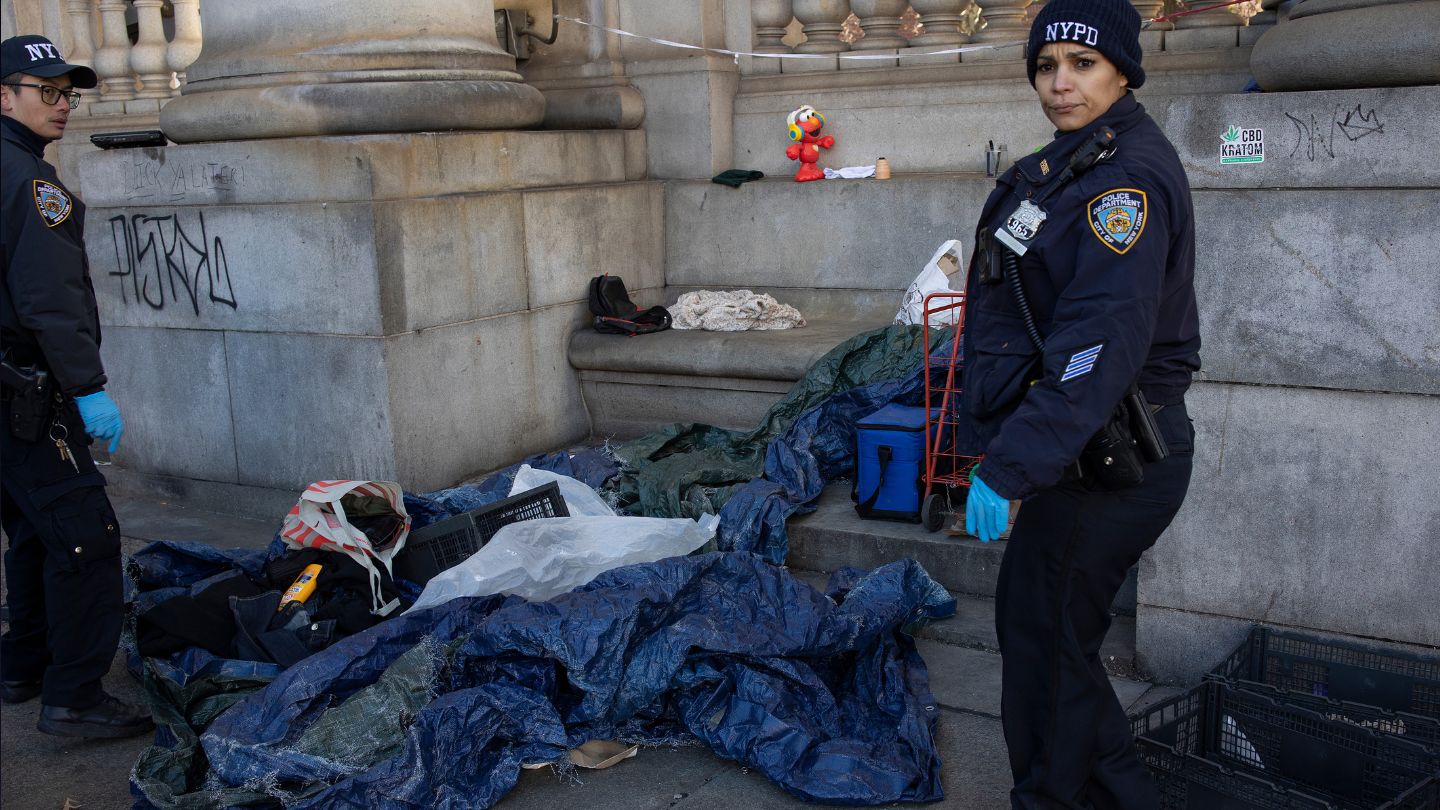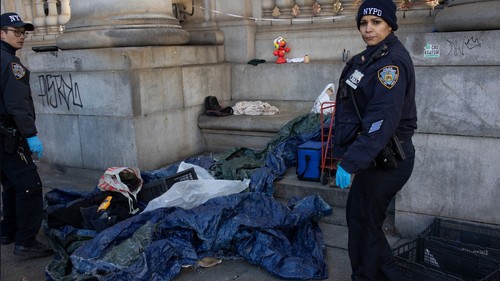A city audit reveals that sweeps encompassing over 2,000 people have largely failed to transition the unhoused into permanent housing.

www.vice.com
NYC's Widespread Homeless Sweeps Resulted in 3 People With Permanent Housing: Report
A city audit reveals that sweeps encompassing over 2,000 people have largely failed to transition the unhoused into permanent housing.
By
Roshan Abraham
June 29, 2023, 2:49pm
IMAGE:
ANDREW LICHTENSTEIN / CONTRIBUTOR VIA GETTY IMAGES'
An audit released on Wednesday reveals that in 2022, New York City Mayor Eric Adams’ “cleanups” of homeless encampments were overwhelmingly unsuccessful at getting people into either permanent housing or temporary shelter.
Comptroller Brad Lander found that only 3 people living in homeless encampments that were swept by the city between March 21, 2022 and November 30, 2022 remain in permanent housing, of 2,308 people living in 161 encampments. 119 people, or 5 percent, accepted temporary shelter; but 29 of them left the shelter the same day and 47 remain in temporary shelter. About a third of the encampments cleared by the Department of Homeless Services (DHS) have been repopulated; 31 percent had already resumed activity as of April 2023, according to the report.
“The low success rate in moving people from the street to shelter and housing as a result of sweeps suggests it is not an effective method to meet the stated goal,” the report says.
In a response to the audit that appears at the end of the report, DHS Deputy Commissioner Christine Maloney wrote, “The report notes that 31 percent of “cleanups” result in encampment re-establishment. Our Agency’s intention, of course, is that each individual avail themselves of our services; however, under current law and regulations, DHS can only offer services and must respect the wishes of individuals who decline.”
Maloney added that some encampments appear again because those sidewalks are inherently appealing to unhoused people. “When a group of individuals experiencing homelessness is connected to services or leaves the encampment sites, others may take their place because of the nature and physical characteristics of the site.”
The audit also says DHS is not collecting important data on individuals when it coordinates homeless sweeps, including the number of people outreach teams have interacted with, which is information that homeless agencies in Portland, San Francisco, and Los Angeles collect. In a response, DHS said that those cities have larger per capita unsheltered homeless populations so the comparison is unfair. NYC’s unsheltered homeless population is 6 percent of its total homeless population, compared to San Francisco’s unsheltered population, which is 57 percent of its total homeless population.
This is both because the temperature on the West Coast makes it easier to survive outdoors and because New York City has a legal “right to shelter” that ensures available homeless shelter space for those who need it.
The city’s encampment sweeps operate through a complaint-driven model in which residents call 311 to report encampments. The NYPD is tasked with confirming the existence of the encampment and then referring a sweep over to the Department of Homeless Services’ Joint Command Center, which sends an outreach team to the encampment to offer temporary shelter or other services to residents of the encampment. The outreach team then refers the encampment to other city agencies, which can include the Department of Sanitation and the NYPD, to conduct a cleanup.
Mayor Eric Adams has publicly pushed for a zero tolerance approach for homeless encampments,
telling the New York Times , “We’re going to rid the encampments off our street and we’re going to place people in healthy living conditions with wraparound services.” While Mayor Adams has been more vocal about homeless encampments than his predecessor, Mayor De Blasio
also initiated hundreds of encampment sweeps while in office.
Lander
released another report on Wednesday calling for a Housing First approach to homelessness that prioritizes permanent housing with social supports without first requiring people enter the shelter system or participate in treatment. 70-90 percent of people who were offered services through Housing First policies remained housed 2-3 years later, according to the comptroller’s analysis of policies across the country, compared to 30-50 percent of policies that required shelter stays or treatment before permanently housing people.
The report said that NYC had applied a Housing First approach to the city’s homeless veteran population 10 years ago leading to a 90 percent success rate. While approving and funding the construction of supportive housing is a challenge, it would cost $68 a day for someone experiencing homelessness to be housed there, compared to $136 a day for a shelter, according to the comptroller’s office. And it would cost dramatically less than hospitalization ($3609 a day) or incarceration ($1414 a day), which are both disproportionate outcomes of street homelessness.
Mayor Adams is currently in a standoff with the city council over requirements for homeless vouchers. He
vetoed a set of bills that would expand eligibility for vouchers, saying it would “saddle taxpayers with billions of dollars in costs each year.”
A City Hall spokesperson contended in a statement that NYC’s efforts have been “indisputably successful.” 181 people in encampments accepted placement between March 18, 2022 and May 31, 2023, according to the city, without clarifying how many people were permanently housed.
“Despite the inherent difficulty of this work, our efforts have been indisputably successful. In the first year of this initiative, New Yorkers experiencing unsheltered homelessness accepted services at six times the rate they did under the previous administration’s approach and a significant majority of cleanups have not resulted in an encampment being re-established,” the spokesperson said. “We also are glad to hear that the comptroller agrees with us on the importance of innovating to get more people housed faster, which is why our administration embraced the housing-first model last year and launched our ‘Street-to-Housing’ pilot. That one pilot alone has already placed nearly 80 New Yorkers experiencing homelessness directly from the street into an apartment. As a result of our robust shelter system and other efforts to help unhoused New Yorkers, New York City maintains a far lower rate of unsheltered homelessness than any other large city in the United States."
Update: This article was updated with a statement from City Hall.
An audit released on Wednesday reveals that in 2022, New York City Mayor Eric Adams’ “cleanups” of homeless encampments were overwhelmingly unsuccessful at getting people into either permanent housing or temporary shelter.
Comptroller Brad Lander found that only 3 people living in homeless encampments that were swept by the city between March 21, 2022 and November 30, 2022 remain in permanent housing, of 2,308 people living in 161 encampments. 119 people, or 5 percent, accepted temporary shelter; but 29 of them left the shelter the same day and 47 remain in temporary shelter. About a third of the encampments cleared by the Department of Homeless Services (DHS) have been repopulated; 31 percent had already resumed activity as of April 2023, according to the report.
“The low success rate in moving people from the street to shelter and housing as a result of sweeps suggests it is not an effective method to meet the stated goal,” the report says.
In a response to the audit that appears at the end of the report, DHS Deputy Commissioner Christine Maloney wrote, “The report notes that 31 percent of “cleanups” result in encampment re-establishment. Our Agency’s intention, of course, is that each individual avail themselves of our services; however, under current law and regulations, DHS can only offer services and must respect the wishes of individuals who decline.”
Maloney added that some encampments appear again because those sidewalks are inherently appealing to unhoused people. “When a group of individuals experiencing homelessness is connected to services or leaves the encampment sites, others may take their place because of the nature and physical characteristics of the site.”
The audit also says DHS is not collecting important data on individuals when it coordinates homeless sweeps, including the number of people outreach teams have interacted with, which is information that homeless agencies in Portland, San Francisco, and Los Angeles collect. In a response, DHS said that those cities have larger per capita unsheltered homeless populations so the comparison is unfair. NYC’s unsheltered homeless population is 6 percent of its total homeless population, compared to San Francisco’s unsheltered population, which is 57 percent of its total homeless population.
This is both because the temperature on the West Coast makes it easier to survive outdoors and because New York City has a legal “right to shelter” that ensures available homeless shelter space for those who need it.
The city’s encampment sweeps operate through a complaint-driven model in which residents call 311 to report encampments. The NYPD is tasked with confirming the existence of the encampment and then referring a sweep over to the Department of Homeless Services’ Joint Command Center, which sends an outreach team to the encampment to offer temporary shelter or other services to residents of the encampment. The outreach team then refers the encampment to other city agencies, which can include the Department of Sanitation and the NYPD, to conduct a cleanup.
Mayor Eric Adams has publicly pushed for a zero tolerance approach for homeless encampments, telling the New York Times , “We’re going to rid the encampments off our street and we’re going to place people in healthy living conditions with wraparound services.” While Mayor Adams has been more vocal about homeless encampments than his predecessor, Mayor De Blasio also initiated hundreds of encampment sweeps while in office.
Lander released another report on Wednesday calling for a Housing First approach to homelessness that prioritizes permanent housing with social supports without first requiring people enter the shelter system or participate in treatment. 70-90 percent of people who were offered services through Housing First policies remained housed 2-3 years later, according to the comptroller’s analysis of policies across the country, compared to 30-50 percent of policies that required shelter stays or treatment before permanently housing people.
The report said that NYC had applied a Housing First approach to the city’s homeless veteran population 10 years ago leading to a 90 percent success rate. While approving and funding the construction of supportive housing is a challenge, it would cost $68 a day for someone experiencing homelessness to be housed there, compared to $136 a day for a shelter, according to the comptroller’s office. And it would cost dramatically less than hospitalization ($3609 a day) or incarceration ($1414 a day), which are both disproportionate outcomes of street homelessness.
Mayor Adams is currently in a standoff with the city council over requirements for homeless vouchers. He vetoed a set of bills that would expand eligibility for vouchers, saying it would “saddle taxpayers with billions of dollars in costs each year.”
A City Hall spokesperson contended in a statement that NYC’s efforts have been “indisputably successful.” 181 people in encampments accepted placement between March 18, 2022 and May 31, 2023, according to the city, without clarifying how many people were permanently housed.
“Despite the inherent difficulty of this work, our efforts have been indisputably successful. In the first year of this initiative, New Yorkers experiencing unsheltered homelessness accepted services at six times the rate they did under the previous administration’s approach and a significant majority of cleanups have not resulted in an encampment being re-established,” the spokesperson said. “We also are glad to hear that the comptroller agrees with us on the importance of innovating to get more people housed faster, which is why our administration embraced the housing-first model last year and launched our ‘Street-to-Housing’ pilot. That one pilot alone has already placed nearly 80 New Yorkers experiencing homelessness directly from the street into an apartment. As a result of our robust shelter system and other efforts to help unhoused New Yorkers, New York City maintains a far lower rate of unsheltered homelessness than any other large city in the United States."
Update: This article was updated with a statement from City Hall.










